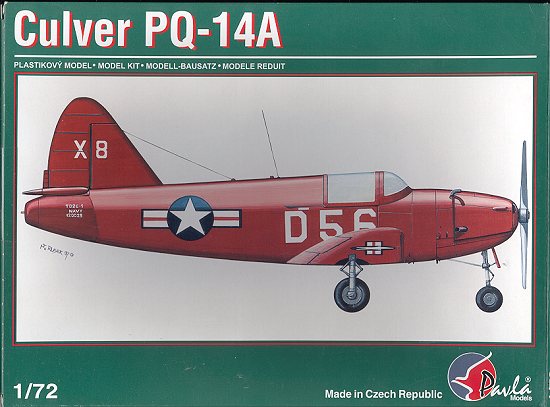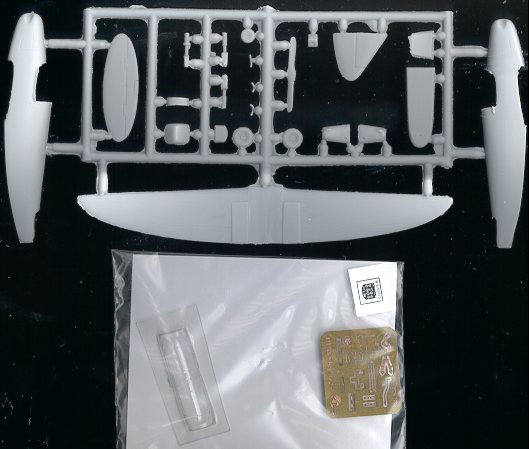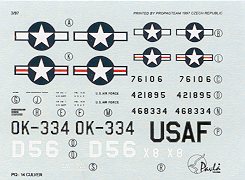
|
KIT: |
Pavla 1/72 Culver PQ-14B |
|
KIT # |
72012 |
|
PRICE: |
$12.98 |
|
DECALS: |
Three aircraft |
|
REVIEWER: |
|
|
NOTES: |
Short run kit. |

|
HISTORY |
In August of 1940, the United States Government initiated a program to perfect the remote piloting of aircraft by radio control in order to safely train aircaft and anti-aircarft gunners. The Culver compnay, then located at a small plant in Columbus, Ohio, was invited with some twenty other aircraft manufacturers to submit designs. The Culver proposal, utilizing it prewar Culver "Cadet" sport plane design, was the only one accepted, and the company subsequently became the sole production supplier of full size radio-controlled aircraft to both the Army and Navy throughout the war.
With the receipt of the first Army contract the Culver Company moved to a larger factory in Wichita, Kansas, where it devoted its entire production facility to this type of aircraft for the duration. Culver completed its final U.S. Navy contract for the same plane (designated TD2C-1) in April 1946 and thereafter devoted its facility entirely to commercial production.
Even though this attractive plane was a drone, it was built with a cockpit to accommodate ferry pilots to back-up safety pilots. A number of "Cadet" drones were converted to civilian sport planes after the war. Pilots of these planes all comment on how pleasant a plane it is to fly and how easy it is to maintain. In addition to those aircraft still flying, two are on display. One at the Pima Museum in Tucson, AZ and the other at the USAF Museum in Dayton, OH.
|
THE KIT |

This kit ranks right there with the BD-5 as being one of the smaller kits in 1/72. What you see of the kit sprues, is pretty well full size (if you have your screen at the recommended resolution and have a 19 inch monitor). Rattles around in the box quite a bit and could have easily been packaged in a box half the size.
Anyway, it is 'typical Czech short run' circa late 90's as this isn't a brand new kit. Sprue attachments are large (use a razor saw), parts all have a bit of flash or rough edges, and detailing is quite fine so it will disappear if any sanding needs to be done. Fortunately, the Culver was not a plane that had much in the way of panel lines.
It will be a major tail sitter so the nose needs to be packed with weight. Not the best for the rather spindly landing gear that comes with the kit. There is a brass fret that includes seat belts, rudder pedals, landing gear oleo scissors, pitot tube and a few other bits. The instrument panel is a photo-type of deal on clear plastic. However, this will need to be glued onto a plastic backing.
 The instructions are fairly good,
but the parts location diagram has little in common with the parts on the sprue
making it a bit difficult to locate some parts. The builder will also have to
make a few parts out of stretched sprue and tubing, but nothing unexpected with
this type of kit. Decals are provided for three aircraft. The decals themselves
are pretty basic, but this is a basic airplane. They are printed by Propagteam,
so you know that the quality is good. The boxtop plane is a Navy TE2C-1 post-war
in Pensacola and is overall insignia red. There is a USAAF one in ANA 614 orange
yellow with wartime insignia and also in orange yellow, a post-war USAAF version
from 1949 with buzz numbers on the side. Just as a note, I'm not sure just how
accurate the orange yellow scheme would be for a post war plane. I've seen both
of the museum planes; they are post war and painted insignia red.
The instructions are fairly good,
but the parts location diagram has little in common with the parts on the sprue
making it a bit difficult to locate some parts. The builder will also have to
make a few parts out of stretched sprue and tubing, but nothing unexpected with
this type of kit. Decals are provided for three aircraft. The decals themselves
are pretty basic, but this is a basic airplane. They are printed by Propagteam,
so you know that the quality is good. The boxtop plane is a Navy TE2C-1 post-war
in Pensacola and is overall insignia red. There is a USAAF one in ANA 614 orange
yellow with wartime insignia and also in orange yellow, a post-war USAAF version
from 1949 with buzz numbers on the side. Just as a note, I'm not sure just how
accurate the orange yellow scheme would be for a post war plane. I've seen both
of the museum planes; they are post war and painted insignia red.
|
CONCLUSIONS |
Hey, what is one to say. It is the ONLY PQ-14 I know of in any scale other than short run resin kits. It is probably not difficult to build, though the small parts may be a bit much for the ham-fisted. One thing for sure, not only will it be a conversation piece, but won't take up much room on your display shelf!
If you would like your product reviewed fairly and quickly by a site that has well over 150,000 visitors a month, please contact me or see other details in the Note to Contributors.